Peak Oil $100 to Deflate Global Stock Markets Speculative Bubble
Stock-Markets / Global Stock Markets Nov 13, 2007 - 01:47 PM GMTBy: Gary_Dorsch

 For the vast majority of Americans who usually don't follow trends in the crude oil futures market, the Global “Oil Shock” only caught their attention after gasoline prices suddenly jumped 15% at the pump this month. Last week, West Texas Sweet crude oil surged to an all-time high of $98.62 /barrel, and greased the skids under the Dow Jones Industrials for a 4% plunge to the 13,000 level, zapping the value of investors' 401k accounts.
For the vast majority of Americans who usually don't follow trends in the crude oil futures market, the Global “Oil Shock” only caught their attention after gasoline prices suddenly jumped 15% at the pump this month. Last week, West Texas Sweet crude oil surged to an all-time high of $98.62 /barrel, and greased the skids under the Dow Jones Industrials for a 4% plunge to the 13,000 level, zapping the value of investors' 401k accounts.
Guy Caruso, the head of the US Energy Information Administration, told reporters on Nov 12th, that the average price US consumers pay for gasoline should rise by another 20-cents a gallon over the next two to three weeks, at the pump. “We haven't seen the full pass-through of high oil prices yet,” he warned.
The stunning rise in the price of crude oil, up 56% this year and up 365% in a decade, to within a whisker of the magical $100 /barrel level, has some traders wondering whether “Peak Oil” is finally here. If correct, is the spectacular bull-run for global stock markets, which is now 4.5-years old, building a major “rounding top” pattern? Until recently, high and rising oil prices didn't disturb the bullish psychology among global stock market operators. Instead, the spin surrounding rising oil prices described a positive story, an unprecedented boom in the world economy.
But historically, Global “Oil Shocks” have tipped the global economy into recession. For example, the Arab oil embargo of 1973-74 and the Iranian Revolution of 1978-79 triggered unprecedented increases in oil prices and were associated with worldwide recessions. Depending on how the adjustment is calculated, $38 a barrel for crude oil in the 1970's would be worth around $96 to $103 /barrel today. Most US recessions in the post-World War II era were preceded by sudden spikes in oil prices.
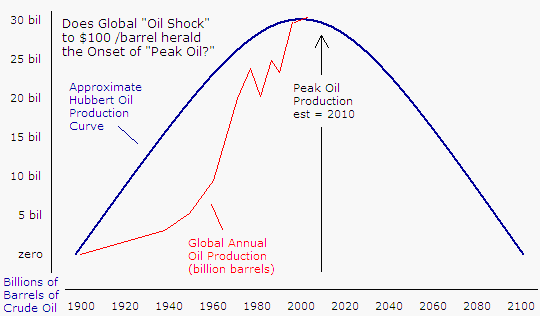
“Peak Oil” refers to the inevitability of a peak in global oil production. Oil is a finite, non-renewable resource, and once half of the original reserves are depleted, oil production is likely to stop growing and begin a terminal decline. In 1956, a US geologist M. King Hubbert figured that the rate of global oil production would follow a bell curve. Once “Peak Oil” production has been reached, output begins to decline and oil prices go up. Hubbert estimated that “Peak Oil” would arrive around 2010.
OPEC sits on about 75% of the world's total proven oil reserves of 1.21 trillion barrels, according to British Petroleum's annual Review of World Energy. “Global reserves are more than sufficient to meet current production levels for more than 40-years, although accessing the oil is getting tougher due to high exploration and production costs, and reserves are also falling under more state control,” BP said.
Some of the biggest proven oil reserves lie in Saudi Arabia, with 264.3 billion barrels, and the Canadian oil sands may contain up to 163.5 billion barrels. But other big sources of crude oil are under the control of the “Axis of Oil,” namely Iran, Russia, and Venezuela, an informal alliance designed to counter US influence in the Middle East. State-owned oil companies already control three-quarters of the world's crude, dwarfing the holdings of major oil companies like Exxon Mobil and British Pete
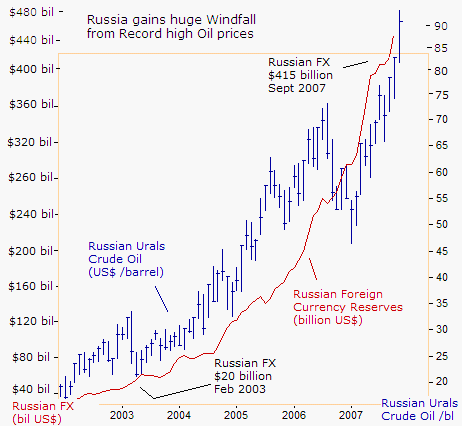
The OPEC oil cartel, which accounts for 40% of the world's production, is gaining enormous power and wealth. OPEC provides almost half of total US crude oil imports, and is expected to rake in a record $658 billion this year from oil exports and $760 billion next year. Russia's foreign currency reserves have soared to $450 billion this month, even after paying off $125 billion of foreign debt.
Iran's Ayatollah Khameini is also the first OPEC leader since Saddam Hussein to demand Euros instead of US dollars, in return for payment of its oil exports, threatening the US dollar's status as the world's reserve currency. On July 19th, Iran asked Japanese refiners to switch to the yen to pay for all crude oil purchases. Russia plans to open the Energy Stock Exchange in St. Petersburg in the first half of next year to trade Urals blend crude oil in rubles.
Of the 65 largest oil producing countries in the world, 54 are past their “Peak Oil” production and are now in decline, including the USA, down 11% since 1971, and the UK's North Sea oil reserves are down 27% since peaking in 1999. Other big oil producers (more than 500,000 bpd) that are in decline include Australia, down 26% since 2001, and Norway, down 13% since 2001. The Cantarell oil field, Mexico's largest has also peaked with its output falling to 1.7 million bpd in 2007, down from its peak output of 2.1 million bpd.
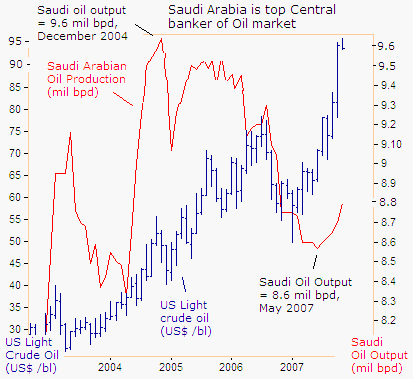
The United States is the world's biggest guzzler of crude oil, consuming 21 million barrels a day, while importing 14 million bpd. But instead of proposing ways for Americans to conserve energy, and reduce their reliance on the foreign imports, the Bush clan is leaning on Saudi Arabia, the central banker of oil, to pump more “black gold”, from its dwindling spare capacity of roughly 2-million barrels per day.
On Nov 11th, Saudi Oil Minister Ali al-Naimi conferred with his Kuwaiti counterpart, and indicated that the OPEC oil cartel would discuss a possible increase in output at the Nov 17-18th meeting in Riyadh. But a possible increase in oil output by OPEC, designed to put a lid over the crude oil market at $100 /barrel, might only buy a few extra months of time, before the next Global “Oil Shock” emerges, and deals another major body-blow to the economies of big oil importers.
“We are of course concerned about high oil prices,” said OPEC chief Mohammed bin Dhaen Al Hamli on Oct 30th. But the market is increasingly driven by forces beyond OPEC's control. It's driven by geopolitical events and the growing influence of financial investors,” said Hamli, who is also UAE oil minister. “We have to stay alert. If the market needs more oil, we will supply it,” he added.
But Riyadh's ability to keep the crude oil market under wraps, by pumping more oil might be drawing to end as early as 2008. The International Energy Agency is forecasting that global demand will climb by 2.1 million bpd to 88 million bpd next year. Global supply however, is forecast to rise a scant 200,000 bpd to 85.6 million bpd, leaving a growing shortfall that would exhaust Saudi's spare capacity.
Global Oil Demand driven by China and India
Demand from China and India alone is expected to double in the next two decades as their economies continue to expand, with consumers buying more cars, moving to cities, and demanding greater access to electricity. China's economy has grown at 10% or more a year since the 1990's, lifting nearly 300 million people out of poverty. As recently as ten years ago, China was a net oil exporter, but in 2006, nearly 50% of its oil consumption was imported from abroad.
India and China are two Asian giants that consume only a third as much oil as the US today, but by 2030 India and China together will import as much oil as the US and Japan do today. If the Chinese and Indians consumed as much oil per capita as Americans do, the world's oil demand would be closer to 200 million bpd, instead of 85 million barrels today. And with the world running on a limited cushion of Saudi spare capacity, any interruption in supplies from Mexico, Nigeria, or hurricanes and talk of armed conflict with Iran, causes oil prices to spike higher.
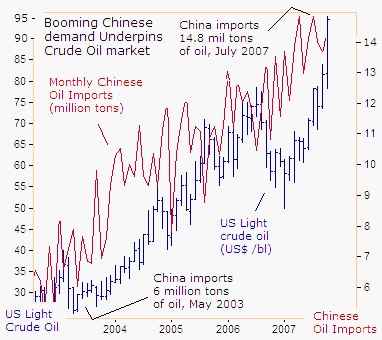
China and India, with a third of the world's population, accounted for 45% of the increase in global energy demand this year. From January thru September, China imported 124 million tons of crude oil, up 14% from the same period in 2006. Sinopec, Asia's top oil refiner, wants to increase crude oil imports from Saudi Arabia by 30% to 600,000 bpd for next year, and also aims to raise imports from Iran. India is set to become the world's third largest oil importer after the US and China before 2025, according to the International Energy Agency (IEA).
Ironically, the Shanghai red-chip market, the world's greatest bull market, might have been a casualty of its economy's insatiable thirst for oil. Shanghai red-chips have been hard hit by a double whammy – the Global “Oil Shock” and multi-year highs in Chinese bond yields. Beijing lifted retail gasoline prices by 10% last week, sparking riots across the country, and fanning the flames of inflation, which is already 6.2% higher from a year ago.
Global “Oil Shock” Rattles Shanghai Red-chips
When Chinese central bankers speak to the media, their comments are usually brief, and subject to mis-interpretation. On October 16th, Chinese central bank governor Zhou Xiaochuan might have signaled a significant shift in monetary policy, indicating a willingness to deflate the Shanghai red-chip bubble, in order to contain inflation pressures in the economy, that threaten the social order of the country.
“Asset prices are not the primary consideration for the bank when it comes to setting monetary policy,” Zhou said. Instead, “combating consumer inflation and increases in global commodity prices are the main reasons why China has been raising interest rates,” he explained. On Oct 28th, PBoC deputy Su Ning added, “We will continue implementing a stable monetary policy leaning toward moderate tightening.
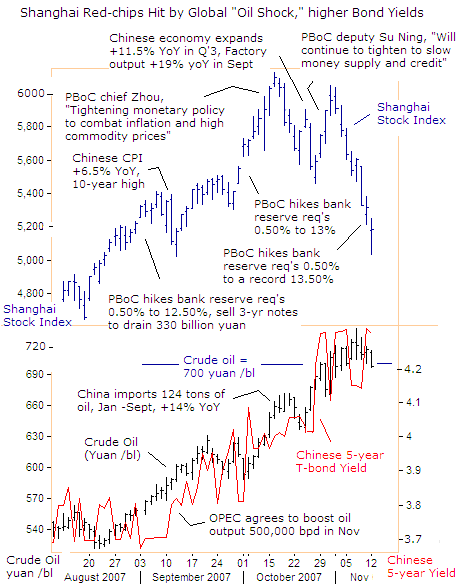
The Global “Oil Shock” lifted prices above the psychological 700-yuan /barrel, and coupled with Beijing's latest monetary tightening, sparked a selling spree in the mighty Shanghai red-chip market to as low as 5,032, off 15% from its all-time high set in mid-October. The People's Bank of China (PBoC) lifted the proportion of deposits that commercial banks must keep in reserve by a half-point to 13.5% for big banks on Nov 10th, to the highest level in nearly two decades.
The latest tightening move is expected to drain 190 billion yuan ($25.6 billion) from the Shanghai money market, and “strengthen the coordinated use of interest rates and the exchange rate to help stabilize expectations of inflation,” the PBoC said. The latest tightening move will mop up the inflows of cash generated by October's $27 billion trade surplus, and is also designed to keep the Chinese 5-year bond yield on an upward trajectory, last seen at 4.30%, up 50 basis points from two months ago.
China might permit faster appreciation of the yuan against the dollar in the months ahead to help offset higher prices for crude oil and other raw materials imported from abroad. From the start of 2007 to mid-October, the yuan rose at an annualized rate of 4.7% versus the dollar. Since then it has been climbing at a rate of nearly 20%, to a record post-revaluation high of 7.41 yuan /dollar. Beijing might also allow the yuan to climb faster, to deflect criticism from its trading partners in Europe.
China posted a record monthly trade surplus of $27 billion in October, as exports grew 22.3% from a year earlier. For the first 10 months the surplus rose 59% to $212.4 billion, outstripping the full-year 2006 sum of $177.47 billion. Chinese exports to the European Union are growing at a 30% clip, twice as fast as shipments to the United States, aided by the yuan's 10% devaluation against the Euro.
Global “Oil Shock,” Stronger Yen, Rattles Japan's Nikkei-225.
Japan imports almost all of its oil, and is the world's third-largest oil consumer after the United States and China. Tokyo has striven in vain for decades to reduce its dependence on oil from the volatile Middle East and thereby insure stable supplies by diversifying oil sources. But in 2006, Japan imported 4.2 million bpd, with 88.6% originating from the Middle East.
Saudi Arabia, the United Arab Emirates and Iran were Japan's three biggest oil suppliers last year. Saudi Arabia shipped 458 million barrels to Japan, or 30% of Japan's import total. The UAE shipped 387 million barrels, for 25.4%, Iran came in third, exporting 176 million barrels, or 11.5%, and Qatar shipped 156 million barrels to Japan in 2006, or 10.2% of Japan's import total.
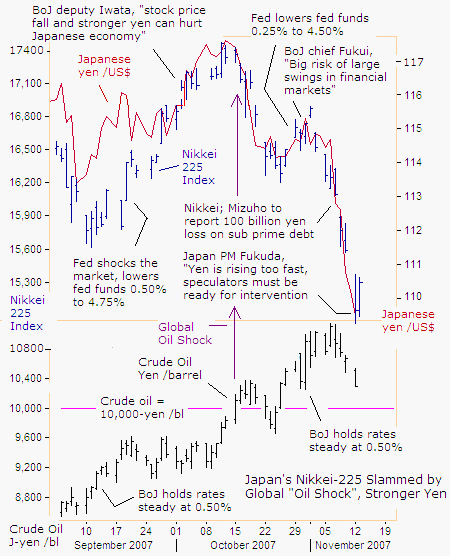
Japan's Nikkei-225 was hard hit by the Global “Oil Shock,” tumbling to a 15-month low of 15,200, down 14% from its mid-October highs. On October 4th, just days before the Nikkei meltdown began, Bank of Japan deputy Kazumasa Iwata, talked about the downside risks for Japan's export-driven economic growth, among them the increased chance of a US economic recession, led by a weak housing sector.
“We need to be aware that stock price falls and the yen's rise, if sustained, could have a negative effect on Japan's economic outlook,” Iwata said in a speech to business leaders in Shimonoseki, Japan. One week later, crude oil rose above the psychological 10,000-yen level for the first time in history, and the dollar topped out at 117-yen, before tumbling to as low as 109.50-yen today, triggering heavy sales of Japanese exporter shares that dominate the Nikkei-225.
Japan's largest bank, Mizuho Financial 8411.T dropped 2.5% at 518,000 yen, extending its losing streak into a fourth session. The bank lost 5.7% on Friday after the Nikkei business daily reported its unlisted brokerage arm may post a sub-prime-related loss of more than 100 billion yen, raising fears that more such losses may lie ahead for other financial companies, compounding the misery for the Nikkei-225.
With the dollar reeling to as low as 109-yen, a key technical support level, and wrecking havoc on the Nikkei-225, Japan's MoF went into actioon “jawboning” the market and threatening outright intervention in the forex market to support the dollar. Japanese Finance Minister Fukushiro Nukaga said on Nov 12th, he is carefully watching developments in both the currency and stock markets, and "will respond carefully to avoid sharp fluctuations in the foreign exchange market."
“The yen is appreciating too fast and speculators need to be careful to avoid the possibility of intervention,” warned Japanese Prime Minister Yasuo Fukuda. “In the short term, yen appreciation would certainly be a problem. Any kind of sudden change in exchange rates would not be desirable. Speculative movements need to be held in check.” Asked if Japan could intervene to hold speculative movements in check, Fukuda said, “I am saying, be cautious,” he warned.
Bernanke Fed is key driver behind historic Oil Rally
The US dollar's slide to yet another record low against the Euro last week, helped maintain the allure of crude oil for speculators who bid “black gold” higher by 40% since mid-August. Oil futures, like gold, offer a hedge against a weaker dollar. Oil prices have soared in the wake of rate cuts by the Bernanke Fed which weakened the dollar, and fed funds futures contracts predict another rate cut next month.
OPEC is likely to discuss creating a basket of currencies for oil pricing at its next summit due to the steady decline in the dollar, Venezuela's Energy Minister Rafael Ramirez said on October 26th. “The need to establish a basket of currencies will be a point of discussion in the next OPEC summit. The dollar as a benchmark currency has been weakening quite a lot and it creates distortions in oil markets,” he said.
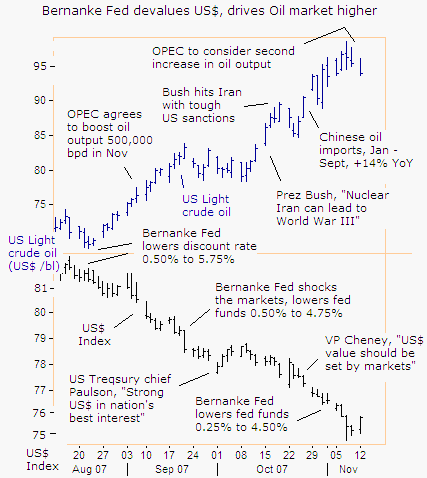
Speculators are placing record bets against the US dollar on ideas the Federal Reserve will continue to lower interest rates, while other central banks hold their rates steady, or tighten their rates further. Net short positions against the dollar in the Chicago futures market rose to a record $32.5 billion in the week ended Nov 6th. However, such extreme net short positions may signal to contrarians that a short lived bounce for the dollar is likely, to shake out overzealous dollar bears.
T estifying before the House of Representatives on Nov 7th, Fed governor Frederic Mishkin said the central bank probably won't take any action to combat the inflationary effects of high oil prices. “It is always important, not to overreact to a rise in oil prices, but actually to think about what is going to happen in the longer run context, and take exactly the steps that will create an environment on which is successful both on the inflation front and on the output front,” he said.
Tension with Iran supports high Oil prices
If a decision is made by the Bush administration to carry out a lightning strike against Iran's nuclear installations next year, the public will only learn of such a surprise attack after most global stock markets have already melted down by 5% or more. The latest volley in the “war of words” between the Bush clan and Tehran since mid-October has already padded oil prices with an Iranian “war premium” of $10 /barrel or more, and is boosting speculative demand for “safe haven” gold.
However, the “war of words” between the Bush clan and Tehran's mullahs over Iran's nuclear program dates back to the US conquest of Iraq's oilfields in March 2003, and to most global stock market operators, the rhetoric sounds more like the “Boy who Cried Wolf.” But if war does come to the Persian Gulf in Mr Bush's final year in office, most likely, it would be the crude oil and gold markets that sniff it out first, while global stock market operators get caught with their pants down.
The Israeli Air Force does not have the capacity to sustain continuous and prolonged attacks against Iran's nuclear installations and economic infrastructure. Only the United States can do that, assuming there isn't a Democratic president in the White House. A Republican administration is more likely to attack Iran in the absence of a political regime change policy, whether there are good military options or not.
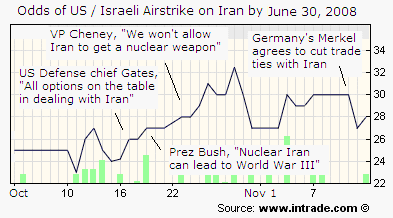
It's difficult to quantify the “Iranian “war premium” that has been built into crude oil prices. Speculators in on-line betting parlors, rate the odds of a US /Israeli strike on Iran by mid-2008 at 28%, up from 24% a month ago. “All options are on the table to halt Iran's nuclear drive, which Israel considers a threat to its existence,” said Israeli Deputy Prime Minister Shaul Mofaz on Nov 10th.
“The strategy for now is one of sanctions, of a united front of nations in that context, and the strategy of declaring without any doubt that all options are on the table. I think like others that the option of using military force is the last resort. But it's clear that the opportunity for a negotiated solution is diminishing if the diplomatic path should not succeed to stop the Iranian nuclear program” Mofaz added.
But in an attempt to deflate some of the Iranian “war premium” that has help lift US crude oil prices to within a whisker of $100 /barrel, and knocked the Dow Jones Industrials below the 13,000 level, Mr Bush started to tone down his tough talk of “World War III” over Iran's nuclear weapons program on Nov 10th, after he secured a pledge from German Chancellor Angela Merkel that Bonn would be willing to support a third round of UN sanctions against Iran.
Merkel, in a visit to Bush's ranch in Crawford, Texas she would also consider cuts in Germany's robust trade with Iran, in exchange for Mr Bush's agreement that diplomacy is the best way to resolve the standoff with Iran. "The threat posed through the nuclear program of Iran is indeed a serious one. But we also are of the opinion that this issue can be solved through diplomatic means. The next step then, obviously, would be a UN resolution,” Merkel said.
Germany is Iran's biggest trading partner, reaping a surplus of 4 billion euros in 2006. German machinery powers most of Iran's industries, transportation and chemical projects. However, there are recent indications that German engineering giant Siemens, has decided to pull out of all new business dealings with Iran, and Germany's three biggest banks, Deutsche Bank, Commerzbank, and Dresdner, have quit Iran after a stern warning from US vice-president Dick Cheney that they would encounter strong barriers to doing business in the US, if they continue to do business with Tehran. European banks store Iran's foreign currency reserves and offer export guarantees.
Global Markets in Un-chartered Territory
Whether the historic rise in crude oil towards $100 /barrel heralds the arrival of “Peak Oil,” or just a speculative bubble that will deflate, are just some of the tough questions in today's brave new world of investing. To stay on top of volatile markets, consider a subscription to the Global Money Trends newsletter, which includes a special bonus for new and existing subscribers, - “Audio Broadcasts”, posted on Monday and Wednesday evenings, during Asian trading hours, to the Log-In section of our website, with our latest analysis of gold, crude oil, base metals, foreign currencies, interest rates and the top stock markets from around the world.
By Gary Dorsch,
Editor, Global Money Trends newsletter
http://www.sirchartsalot.com
This article is just the Tip of the Iceberg, of what’s available in the Global Money Trends newsletter! Here's what you will receive with a subscription, Insightful analysis and predictions for the (1) top dozen stock markets around the world, Exchange Traded Funds, and US home-builder indexes (2) Commodities such as crude oil, copper, gold, silver, the DJ Commodity Index, and gold mining and oil company indexes (3) Foreign currencies such as, the Australian dollar, British pound, Euro, Japanese yen, and Canadian dollar (4) Libor interest rates, global bond markets and central bank monetary policies, (5) Central banker "Jawboning" and Intervention techniques that move markets.
GMT filters important news and information into (1) bullet-point, easy to understand analysis, (2) featuring "Inter-Market Technical Analysis" that visually displays the dynamic inter-relationships between foreign currencies, commodities, interest rates and the stock markets from a dozen key countries around the world. Also included are (3) charts of key economic statistics of foreign countries that move markets.
A subscription to Global Money Trends is offered at only $150 US dollars per year for “44 weekly issues”, including access to all back issues. Click on the following hyperlink, to order now, http://www.sirchartsalot.com/newsletters.php Call toll free from USA to order, Sunday thru Thursday, 2 am to 4 pm EST, at 866-576-7872.
Mr Dorsch worked on the trading floor of the Chicago Mercantile Exchange for nine years as the chief Financial Futures Analyst for three clearing firms, Oppenheimer Rouse Futures Inc, GH Miller and Company, and a commodity fund at the LNS Financial Group.
As a transactional broker for Charles Schwab's Global Investment Services department, Mr Dorsch handled thousands of customer trades in 45 stock exchanges around the world, including Australia, Canada, Japan, Hong Kong, the Euro zone, London, Toronto, South Africa, Mexico, and New Zealand, and Canadian oil trusts, ADR's and Exchange Traded Funds.
He wrote a weekly newsletter from 2000 thru September 2005 called, "Foreign Currency Trends" for Charles Schwab's Global Investment department, featuring inter-market technical analysis, to understand the dynamic inter-relationships between the foreign exchange, global bond and stock markets, and key industrial commodities.
Copyright © 2005-2007 SirChartsAlot, Inc. All rights reserved.
Disclaimer: SirChartsAlot.com's analysis and insights are based upon data gathered by it from various sources believed to be reliable, complete and accurate. However, no guarantee is made by SirChartsAlot.com as to the reliability, completeness and accuracy of the data so analyzed. SirChartsAlot.com is in the business of gathering information, analyzing it and disseminating the analysis for informational and educational purposes only. SirChartsAlot.com attempts to analyze trends, not make recommendations. All statements and expressions are the opinion of SirChartsAlot.com and are not meant to be investment advice or solicitation or recommendation to establish market positions. Our opinions are subject to change without notice. SirChartsAlot.com strongly advises readers to conduct thorough research relevant to decisions and verify facts from various independent sources.
Gary Dorsch Archive |
© 2005-2022 http://www.MarketOracle.co.uk - The Market Oracle is a FREE Daily Financial Markets Analysis & Forecasting online publication.


